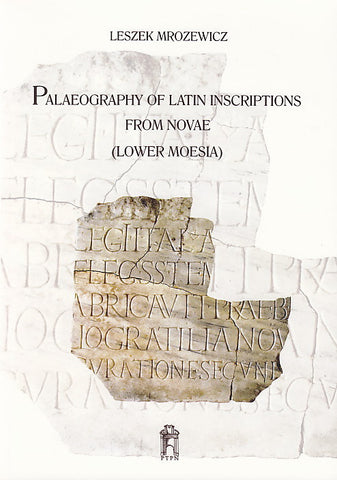Paleography of Latin Inscriptions from Novae (Lower Moesia)
35,00 $
ISBN: 978-83-7654-041-2
Description: softcover, 24x17cm, 223 pages, drawings, photographs
Condition: very good
Weight: 520g.
L. Mroziewicz, Paleography of Latin Inscriptions from Novae (Lower Moesia), Poznan 2010
Introduction and Acknowledgments
Chapter I. What is palaeography? Epigraphy and palaeography
Chapter II. Inscriptions from Novae: the state of the art
Chapter III. Analysis of the epigraphic material from Novae. Dated inscriptions
1. Inscriptions dated sensu stricto: tituli cuius annus notatus est
2. Inscriptions possible to date: tituli cuius annus non notatus est
CHAPTER IV. Dating criteria
1. Official inscriptions
2. Private inscriptions
3. Votive inscriptions
4. Building inscriptions
5. Sepulchral inscriptions
6. Inscription form
CHAPTER V. Execution of an inscription
1. Tools and material
2. Founders, executors
3. Location of the text
4. Quality: how errors arise
5. Did an epigraphic workshop exist in Novae?
CHAPTER VI. Freehand (common) inscriptions
1. Graffiti on bricks: leg 1 Ital
2. Donjon graffito in defensive wall: leg XI Claudia
3. Lead bar with fourteen inscriptions
4. Painted inscription; were there more of them?
CHAPTER VII. Stone inscriptions
LScripturamonumentalis
2. Scriptura capitalis (quasi)cursive (octuorio)
CHAPTER VIII. Abbreviations
1. Suspensions
2. Ligatures
CHAPTER IX. Damnatio memoriae
CHAPTER X. Punctuation marks (hederae, triangles, and other)
CHAPTER XI. Numerical data (numerals)
CHAPTER XII. Lettering (letter shapes)
CHAPTER XIII. Tabular compilation of lettering in Novae
- Table I. Lettering from the 1st and beg. of the 2nd century
- Table II. Lettering in the 2nd century
- Table III. Lettering in the Severan period
- Table IV Lettering in the 2nd - 3rd century
- Table V. Lettering in the 3rd - 5th century
- Table VI. Examples of ligatures
CHAPTER XIV Comparative background (outline)
Bibliography with Abbreviations
APPENDIX
Catalogue of inscriptions
A-B: Novae - dated inscriptions
1. A inscriptions dated sensu stricto: tituli cuius annus notatus est
2. B inscriptions possible to date: tituli cuius annus non notatus est
3. C undated inscriptions
4. D inscriptions from outside Novae
5. Compilation of cursive inscriptions:
- Table I. Lettering in painted cursive (B24)
- Table II. Examples of cursive lettering in Novae
- Table III. Ligatures in cursive writing in Novae
- Table IV Pompeian cursive
- Table V Cursive from Alburnus Maior
- Table VI. Examples of cursive from Vindonissa (the outer side of the plates)
- Table VII. Examples of cursive from Vindonissa (the inner side of the plates)
- Table VIII. Cursive from La Graufesenque
- Table IX. Dated cursive from La Graufesenque
6. Non-epigraphic monuments in Novae: tituli picti?
7. Squeezes of some inscriptions from Novae
Palaeography is a study of the history of handwriting, its peculiarities and development throughout centuries. By definition then it does not deal with print, nor has it been interested, at least for a long time, in inscriptions engraved in solid materials, stone included. Classic handbooks in palaeography devote only little attention to such inscriptions, and view them exclusively in the perspective of the history of writing, rarely consulting the documents from the period. Palaeographers left the whole area of the study of inscriptions to epigraphy. A change of the attitude occurred with the works of J. Mallon and R. Marichal, who insisted that inscriptions should become the object of palaeography. Cutting inscriptions in stone is, according to J. Mallon, an ending of a process pertinent to the discipline. The fact that inscriptions are made with the help of a chisel and hammer should not diminish their meaning for palaeography.
To an epigrapher, Novae on the Danube in Lower Moesia is in some measure an ideal object. There are as many as two corpora of inscriptions available, the first of which includes Latin inscriptions found during excavations that took place from 1960 till 1989. The second contains all inscriptions from Novae until the first half of 1996, Greek and Latin, both those known already before the excavations and those discovered in the excavations. All in all, we have 230 Latin inscriptions to our disposal. Although from the perspective of the five-hundred-year history of Novae the amount is moderate, it can serve as a departure point for reflections on the history of the legionary fortress and the town, soldiers and civilians.









